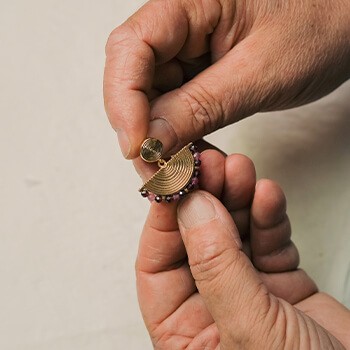SALES 50% OFF DISCOVER
FREE SHIPPING FROM €49 - DELIVERY IN 48H*
MADE IN MENORCA, SPAIN
-
MenuBack
- Sales 50% OFF
- MARÍA G. DE JAIME
- New In
-
Jewels
-
-
Separator
-
Zirconia ringsNEW
-
View all
-
Separator
-
View all rings
-
-
Separator
-
Separator
-
View all earrings
-
-
Separator
-
Separator
-
View all necklaces
-
-
Separator
-
Rigid braceletsNEW
-
Separator
-
ALL BRACELETS
-
-
VIEW ALL
-
-
-
Summer 2024
-
-
Collections
-
-
-
-
-
Summer EditNEW
-
-
Ver colección María G. De Jaime
-
-
Gift ideas
-
-
-
-
-
Ver colección María G. De Jaime
-
-
About Us
-
-
-
Discover our story
-
-
Jewelry finishes
If you have ever wondered what the difference is between "plated" or "coated," you should know that it refers to the amount of gold, silver, platinum, rhodium, or other precious or semi-precious materials with which a metal is covered. For your information and peace of mind, at VIDAL & VIDAL, we only work with high-quality coatings that are over 1 micron thick, traditionally known as "plating," which has always been synonymous with higher quality.

What is a plated or coated piece?
As we have mentioned, "plating" or "coating" is a process by which a metal (such as bronze, brass, or even silver) is coated with another more valuable metal like Gold, Silver, Platinum, or other precious or semi-precious metals as needed. Since it is the final process applied to the piece, depending on the plating or coating used, the external appearance of our jewelry will vary.

There are different types of platings or coatings:
Silver Plating or Coating
Pieces to which a coating of Sterling Silver or Silver 925 is applied.
18 Kt Gold Plating or Coating
Pieces to which a coating of 18 Kt Gold is applied. It can have different color tones like yellow, rose, etc.
Rhodium Plating or Coating
Pieces to which a coating of Rhodium is applied. Rhodium is a precious metal, like Gold or Platinum. It has a slightly darker color than Silver and is used in pieces that include white zirconia, as it enhances their brightness.
Platinum Plating or Coating
Pieces to which a coating of Platinum is applied. Platinum is a precious metal, like Gold or Rhodium. It is widely used in high jewelry to finish pieces with diamonds. This is the finish we give to our Signature collection. It's worth noting that plating or coating has nothing to do with the material of the piece's body. We'll explain this to you in the next post.

Spanish law does not indicate the minimum thickness that must be applied to each jewel to be called "plated" or "coated," so the quality of the coatings may vary according to each brand or manufacturer's criteria. Thus, even though the appearance of two pieces may be exactly the same, their thickness will determine the durability of the coating: the thinner, the less durable.
We are proud to be manufacturers because we can have absolute control over the thickness and quality we give to each piece. We can assure you that we review each piece, one by one, to ensure its finish is impeccable.
What differentiates "Gold Plating" from "Gold Plating"?
At first glance, nothing. Let's remember that the appearance of a piece only shows the last layer of metal we have given it: the human eye cannot differentiate the microns of gold or silver that a piece carries. But as we have already seen, a piece with a plating equal to or greater than 1 micron is considered plated, as is the case with 100% of our jewelry.
What is "Bañado" then?
"Bañar" (Bañado) only indicates the function of immersing a piece in various processes to give it the desired finish.
So when do we call them Plated?
This designation is associated with a concept of higher quality regarding the thickness of the finish and the durability of the piece, as is the case with all our "plated" pieces. Brands that have their own factory are very familiar with industrial manufacturing processes; we continue to internally call the finish of the jewelry "Plated."
Vidal & Vidal uses its own (necessary) and third-party cookies to personalize content, offer social network functions and analyze traffic.
Más información en la política de cookies.
You can customize or reject cookies through this box.
Cookie Preferences
Necessary Cookies
Estas cookies son esenciales para permitirle moverse por el sitio web y utilizar sus funciones, como acceder a áreas seguras del sitio web. El sitio web no puede funcionar correctamente sin estas cookies.
Analysis cookies
Estas cookies nos permiten monitorear y mejorar el rendimiento de nuestro sitio web.
Advertising cookies
Nuestros socios publicitarios pueden establecer estas cookies a través de nuestro sitio. No almacenan directamente información personal. Si no permite estas cookies, experimentará publicidad menos dirigida.
Cookies funcionales
Estas cookies permiten que el sitio proporcione una funcionalidad y personalización mejoradas.




